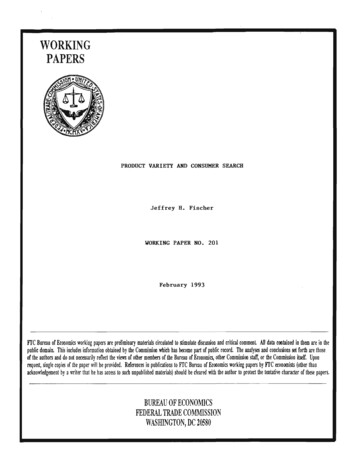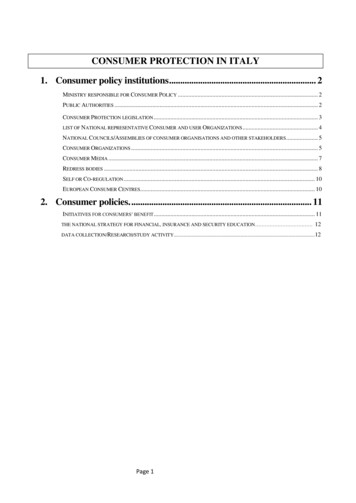
Transcription
WORKINGPAPERSPRODUCT VARIETY AND CONSUMER SEARCHJeffrey H. FischerWORKING PAPER NO. 201February 1993FIC Bureau of Economics working papers are preliminary materials circulated to stimulate discussion and critical commenl All data contained in them are in thepublic domain. This includes information obtained by the Commission whicb bas become part of public record. Tbe analyses and conclusions set forth are thoseof tbe autbors and do not necessarily reflect the views of other members of the Bureau of Economics, otber Commissioo staff, or the Commission itself. Uponrequest, single copies of the paper will be provided. References in publications to rrc Bureau of Ecooomics working papers by FIC economists (other thanacknowledgement by a writer that he has access to such unpublished materials) sbould be cleared with the author to protect the tentative cbaracter of these papers.BUREAU OF ECONOMICSFEDERAL TRADE COMMISSIONWASHINGTON, DC 20580
Product Variety and Consumer SearchJeffrey H. Fischer*January 1993Federal Trade CommissionAbstract: Previous work on consumer search has shown that consumers facingpositive search costs do not sample more than one firm; that is, no search occursin equilibrium. This result, as well as the price charged, are independent of themagnitude of search costs. I develop a model in which consumers search for amost-preferred variety of a heterogeneous product. If products are sufficiently differentiated, consumers will sample additional firms and, consequently, search costsaffect both the price charged and the probability of search."Bureau of Economics, Federal Trade Commission, Washington, DC, 20580. Opinions expressed in this paperare those of the author and are not necessarily those of the Federal Trade Commission. I would like to thankJoe Harrington, Bruce Hamilton, Ralph Chami, and Vandana Chandra for their contributions and the timethey took from their own work, as well as participants at Johns Hopkins University and the 1991 SoutheasternEconomic Association meetings. As always, the usual disclaimers apply.
1IntroductionAnyone who has shopped around for a particular type of good knows what it is like to searchfor the right variety at the right price. Uncertainty about the location of stores with low pricesand stores with desirable products causes consumers to waste time and effort on search. If theuncertainty were only over price, wasteful search could be eliminated by a series of phone callsor through advertisements.! To logically explain consumer search, one must recognize that akey cause of search is product heterogeneity; in particular, heterogeneity of a type that requiresvisiting a store before learning the desirability of that store's product so that advertising is nota substitute for search. It is this aspect of search that is missing in most existing models. Thispaper corrects this omission, using the framework of optimal consumer search decisions in aheterogeneous product market.This paper models consumer search decisions when goods and preferences are heterogeneous.The goal of the paper is to argue that heterogeneity is necessary for the equilibrium distributionof prices to be such that consumers are willing to search in a nontrivial way. 2In the theory of consumer search,3 two paradoxical results are prominent: first, that consumers facing positive search costs do not sample more than one firm; and second, that thisresult, as well as the price firms charge, is independent of the magnitude of search costs. Thatis, any positive search cost causes consumers to behave in a manner completely opposite tobehavior when search costs are zero.To some extent, then, search theory is misnamed: consumers do not search at all in anymeaningful way. By "search," I mean that some measure of consumers will go to one store,1 In fact, this is the way consumers often purchase some products. For example, mortgage rates are availablethrough both newspaper articles and by phone. Airline ticket prices are advertised in newspapers, on-line services(such as EasySABRE), and are available over the phone. Some mail-order products, such as coffee, are sold onthe basis of price alone. Much advertising, for products as diverse as groceries and mattresses, is devoted toconvincing the consumer that a particular store has the "guaranteed lowest price." The common denominatorfor these products is that they are all fairly homogeneous: price is the main characteristic that distinguishesamong firms.2By "nontrivial" I mean that at least some consumers with positive search costs, given the expected distribution of prices and varieties, will rationally search more than one store. This definition excludes search byconsumers with no search costs (Butters [1977J, Stahl [1989]); search which does not maximize utility (Wilde andSchwartz [1979]); or search rules based on conjectures of behavior which does not hold in equilibrium (Carlsonand McAfee [1983J and Wolinsky [1983]).3This paper considers search over horizontally differentiated goods. Horizontal product differentiation isdefined through different preference rankings across consumers of the available varieties. In contrast, verticaldifferentiation requires that all consumers rank the varieties the same way, though differences in an individual'sdemand for a variety at a given price may vary. Differences in product quality, rather than differences inpreferences, fall under the category of vertical differentiation. I do not deal with differences in quality acrossfirms.1
observe the price and the variety sold there, and decide to sample additional stores before purchasing one of the varieties. Firms are able to exploit consumers' uncertainty about the locationof low-price sellers in such a way as to make a high-price equilibrium possible: since consumerscannot observe deviations from the proposed equilibrium price without search, firm demand isinelastic to unilateral changes in price, relative to full-information models. Consumers do notexpect price-undercutting behavior, so the benefit to search is nonexistent. As a result, searchwill not occur if search is costly. Since no search occurs, no firm wants to deviate from theproposed equilibrium by undercutting other firms.In particular, Diamond (1971) showed that consumers facing positive search costs will notsearch for low prices, but will instead buy from the first firm sampled. Because consumersexpect high prices and no deviations from the high price, firms are able to charge the monopolyprice despite the presence of a large number of competitors all selling identical products. Furthermore, Diamond's results hold regardless of the magnitude of search costs.Subsequent work has shown that Diamond's results are robust to certain changes in his basicmodel. Stahl (1989) introduced into the Diamond model a set of consumers for whom searchcosts are zero. These consumers sample all firms, buying from the lowest-priced firm, and indoing so act to restrain the prices firms can charge. As the percentage of these zero-search-costconsumers grows, prices converge to the competitive solution. Even in Stahl's model, however,no consumer with positive search costs samples more than one firm. Consequently firms withabove-average prices still make some sales, even though all consumers are aware that lowerprices may exist. Earlier, Butters (1977) assumed that some consumers received advertisingmessages from firms, in which case they would purchase the product from the firm with thelowest advertised price, while other consumers received no advertising messages and "searched"for an acceptable price. The consumers who received messages had zero search costs for thesubset of firms from which they received messages. Like Stahl, consumers with positive searchcosts all purchased from the first firm sampled, so no search occurred in equilibrium.4The aspect of the Diamond, Stahl, and Butters papers that drives their counterintuitiveresults is that all firms sell identical products. Since price is the only characteristic of the goodthat may vary across firms, firms set prices such that any differences in price across firms isinsufficient to offset the expected search costs a consumer would incur in finding the low price.I model firms' products as different varieties of a heterogeneous good. The heterogeneityis horizontal, rather than vertical: not all consumers rank the varieties in the same way. For·See Stahl (1989) for a survey of other papers of consumer search.2
some prices and enough heterogeneity, some consumers will not buy from the first firm sampled,preferring instead to continue search for sufficiently low search costs. If search costs are high,these consumers will not purchase the commodity at all. If search costs are sufficiently low,however, the expected benefit of search outweighs the expected costs, so additional search willoccur.In contrast, consider a model of search over a homogeneous product when all consumershave positive search costs. Price is the only object for which to search. Thus for consumers tomake nontrivial searches, consumers must expect prices to differ across firms. However, a firmcan improve upon any proposed equilibrium involving a distribution of prices by increasinghis price by less than the lowest cost of search. Since consumers make an initial search basedon the expected distribution of prices, no shopper who reaches the deviating firm will fail tobuy from that firm if he would have bought under the proposed equilibrium price. Hencethe proposed price distribution is not an equilibrium. With product heterogeneity as well asheterogeneity across consumers, consumers who find products sufficiently far removed fromtheir utility-maximizing choices will incur an additional search cost in an attempt to find acloser match. Thus some kind of heterogeneity is a necessary part of a search equilibrium. 5In this model, two firms each produce one variety of a heterogeneous product. Each varietyis a random draw from a distribution of varieties; the distribution is common knowledge to bothfirms and consumers. All consumers incur a common search cost to sample the second firm.The model shows that, in contrast to the established literature, (1) equilibrium search occurs forsome parameter values; and (2) the average price charged by firms depends positively on searchcosts. The intuition is that sufficiently low search costs, relative to the degree of heterogeneityamong the varieties, induces search on the part of consumers for whom the variety sold by theinitial firm sampled yields little utility. Enough product heterogeneity makes each firm want tosell to those consumers who value its variety highly, rather than simply sell to those "captive"consumers who sampled that firm first, because the higher price received from these consumersmore than offsets the loss in demand from consumers who do not value the firm's variety ashighly. In contrast, no search occurs in the Diamond model. In addition, unlike Diamond,the price charged depends on the search cost. I obtain Diamond's results when the degree ofheterogeneity is small relative to search costs, making search for a more-preferred variety anunattractive proposition. Finally, I show that increasing the degree of heterogeneity results inSIntroducing noise into the system, in consumers' perceptions of either the products or pricing, is a mechanismto create heterogeneity artificially. See Burdett and Judd (1983).3
higher equilibrium prices as long as equilibrium does not involve serving the entire market.22.1The ModelFirms and varietiesTwo firms each produce a varietydefined by a pointK,.Firm i knowsXiXiXi,i 1,2 randomly drawn from a set X, so a firm isEX. I take the set X to be the points on a circle with circumferencebut notXj.The space of varieties is shown in Figure 1. (See Salop[1979) or Wolinsky [1983] for other models involving circular product spaces.) One way tomodel increasing heterogeneity is through increases in the circumference of the circle, whichis equivalent to an increase in the span of consumer valuations of varieties. This is the casein which more varieties are available, and the new varieties are refinements of the old ones.Alternatively, one can model increasing heterogeneity through an increase in the disutility aconsumer receives for a given distance away from his most-preferred variety. In this case thenumber of varieties remains constant, but varieties become less substitutable for one another.Since the latter scenario is closer in spirit to the standard concept of heterogeneity, this is thetopic I explore in Section 4.A strategy for firm i is a price Pi. I restrict prices to the interval [b, v], where v is themaximum amount any consumer would be willing to pay for a particular variety and b is thecommon marginal cost; this assumption is innocuous, because profits for all prices abovev arezero and are negative for all prices below b.Firm i (correctly) believes that the location of firm j is determined solely by a draw fromX, that firm j charges a price p*, and that this price is a common expectation across firms andconsumers.Firm i chooses price Pi given his expectation that firm j has a price p* to maximize expectedprofits, which are given by(1)where di(Pi) is the (expected) demand to firm i when Pj2.2 p*.Consumers and searchA consumer is defined by a point in the set X representing his most- preferred variety. Eachconsumer I has a most-preferred variety x which yields a surplus ofVjvaluations decreaselinearly away from the most-preferred variety, so that, for some product4Xi,the surplus to
consumer I is(2)whereYi IXi -II is the minimum arc distance from the point on the circle denoting Xi to thatdenoting consumer I.Yihas support [0, ,.,;/2]. Preferences are distributed such that the densityof types I are distributed uniformly around a circle whose points are the set of varieties X; justas many consumers haveXias their most-preferred variety as any other variety xi' Denote byx the most-preferred variety of consumer I.Consumers search until they find utility that satisfies their stopping rule. Consumers donot have any information a priori as to whetherXiorXjis closer to its most-preferred product,so consumers pick an initial firm at random. Once at the initial firm, a consumer may buy,search a different firm, or opt out of the market. The surplus to buying is V1(Xi) - Pi for a pricePi; the surplus to opting out is normalized to zero; and the surplus to searching firm j is2:. fV1(Yi )dy - p* - c ES(p*) - c,.,; } Y; e(O,K/2jwhere c is the cost of searching firm j, ES(p*) is the expected surplus (net of price) from search,and a consumer expectsPj p*.The integral yields an expected valuation from an additionalsearch. The term 1/,.,; adjusts for the size of the circle and hence the number of availablevarieties: as ,.,; increases, the probability of a search yielding a variety further away from themost-preferred variety increases, lowering the valuation expected from search.Consumer demand is perfectly inelastic: a consumer will buy exactly one unit of the goodas long as the surplus from some firm is positive. He will purchase this unit from firm i if hissurplus there is positive and greater than his expected surplus from searching firm j. Thus aconsumer initially at firm i will buy from firm i if and only if(3)and will search ifV1(Yi) - Pi ES(p*) - c and ES(p*) c.(4)The first relation in (3) indicates that the surplus at the current store exceeds the expected surplus from search, while the second ensures that the actual surplus from buying is nonnegative.Similarly, the first relation in (4) indicates that the expected surplus from search is higher thanthe surplus from buying from the current store, while the second requires that the expectedsurplus is at least as great as the search cost (so that search is optimal).5
Once at firm j he observes x j and Pj, but loses any information aboutXiand Pi. A consumereither loses information about the precise combination of characteristics he previously observed,thus "forgetting" his private valuation of the object, or realizes that the product( s) offered maychange while he engages in further search. I make this assumption in order to generate a smoothdemand curve for each firm based on a reservation-brand/price combination. Without thisassumption of no recall the model would exhibit a fundamental asymmetry between consumerswho have searched all the firms and those who have searches remaining. The two consumertypes that this asymmetry creates-those who have searches remaining and those who do notrespond differently to changes in prices. If firms are unable to identify members of each groupand charge a price according to a consumer's remaining search opportunities, no pure-strategyprice equilibrium exists. While obtaining a pure-strategy equilibrium is not essential, doing somakes the subsequent analysis cleaner and does not create the conceptual difficulties associatedwith mixed-strategy equilibria.With the no-recall assumption equations (3) and (4) are independent of the number ofsearches a consumer has already made. The no-recall model is asymptotically the same as amodel with recall: as the number of firms tends to infinity the number of consumers who havesearched all the firms without buying becomes insignificant to the demand of any individualfirm.6 To avoid consumers repeatedly searching the same firm, I assume that consumers maynot search the same firm consecutively.7This setup generates a reservation brand (see Kohn and Shavell [1974]): a consumer of typeI will purchase from firm i charging p* as long as the net expected surplus from search is lessthan the search cost; that is, for all Yi such thatl1Yi-'"[v I (Yj) - vI (ydJdYj ::; c.(5)0The reservation brand for a consumer of type 1 is defined by a distance R from consumer I'smost-preferred variety, where R is such that (5) holds with equality:(6)Note that if R ",/2, search costs are sufficiently low relative to the number of availablevarieties and the disutility parametere that all brands satisfy the stopping rule and no search6Implicit in the model of Wolinsky (1983) is the no-recall assumption; otherwise he could not use thereservation-brand property he employs. See Kohn and Shavell (1974).7This assumption is innocuous since a process of random search will generate the same expected demand tofirms and the same expected utility to consumers as long as the entire search phase takes place before firms havethe opportunity to changes prices or brands.6
takes place.I return to this topic in Section 3, where I consider the possibility that theprobability from buying after sampling an initial brand is one. Also note thatso, from (6),R J2;C.(7)Consumer 1 responds to price deviations as follows: he will accept a brand priced at Pii- p*as long as VI(Yi) is at least as high as vl(r), where vl(r) is defined by(8)Equation (8) says that the minimum acceptable brand must generate just enough additionalsurplus to offset any price increase above p*. Simplifying (8),Iri(Pi) -II IR 11- ( p' t()P*) (9)Note that ri(Pi) is a function of Pi, given p*. Then from (9) one can see that1()(10)and(Pri--2OPi o.The above equations are a result of the assumption that utility decreases linearly in price.Since an interior solution requires that some consumers do not find both brands acceptable,I restrict attention to the case where R ",,/2. Using (7), R ",,/2 if "" 8c/().2.32.3.1Firm demandKnown brandsI first consider the demand for firm i whenXjis known, then integrate over the set of possiblebrands to generate expected demand.Givenxj,di(Pi;Xj)denotes the demand for firm i at price Pi. Demand consists of thenumber of customers who would be willing to buy from firm i if they sampled firm i beforebuying a variety, times the probability each will buy. The number of customers willing to buyfrom firm i, {I:11- Xii ri(Pin, is an arc of distance ri(Pi) on either side of Xi, multiplied by7
ry, the density of consumers, and divided by the circumference of the circle: 2ryTi(Pi)/I'b. Theprobability that a consumer on this arc will buy is the inverse of the number of acceptablebrands such a consumer has. Some consumers are willing to buy from either firm; some willbuy from firm i but not from firm j; and some will buy from firm j but not from firm i. DefineL;(Pij R) {/: 1/- xjlL[(Pij R) R} n {I : 1/- xii :S Ti(Pi)}II - xjl :S R} n {I : 1/- xii :S Ti(Pi)}{I:and define J.L( LD and J.L( Lt) as the measure of consumers in L; and L;, relative to the entirecircle, so J.L(LHpj,I'b/2)) 0 andJ.LCL;(pi,I'b/2)) J.LC{I: 11- xii:S Ti(Pi)}). L; represents theset of consumers who would buy from firm i at price Pi but would not buy from firm j locatedat x j at price p*. Thus the proportion of consumers in Lf-J.L( Lf )-buying from firm i is 1. L;represents the set of consumers who are willing to buy from either firm i at price Pi or fromfirm j at price p*j the firm the consumer actually buys from is the one the consumer shops first.For consumers in L;, both Xi and Xj are similar enough to I that the pairs (Xi,Pi) and (xj,p*)satisfy the stopping rule. These consumers-J.L(L7)-will buy from firm i with probability 1/2under the assumption that consumers visit firms randomly.Denote by {{, I} the set of consumers for whom1/ - xii Ti(Pi)j these consumers areindifferent between buying from firm i at Pi or continuing search. Then{ -2/0&J.L(Lf) -I/O&pi-I/O0ififififkI, IELi ,kI E Li and I- f/.I- E L kj and I f/.I, I- f/. Lik .kLi ,Lik ,(11)&J.L(Lf)/&Pi is linear and continuous everywhere except at a finite number of points where thefunction jumps. Hence&2 J.L( Lk).: 2,.--:;. O&Pieverywhere but at those points where the derivative does not exist.Given any location for x j, the consumers willing to buy there--those I for whomII -x j I :SR-are all those within a distance 2R of x j. Hence the proportion of such consumers is 2R/ I'b.Similarly, the consumers willing to buy at firm i-those for whomII -xii :S Ti(p;)-are allthose within a distance 2Ti of Xi. The proportion of these consumers is 2Ti/I'b.Demand to firm i is the number of consumers, ry, multiplied by the proportion willing to buyat firm i, multiplied by the probability each consumer withinfinding a suitable brand elsewhere. J.L(Tjof Xi would shop at Xi beforeLD of these consumers have no acceptablp8rllternatives
and will buy from firm i regardless of the order of search; J.l(Lt) have a choice between firm iand firm j and hence will buy from firm i with probability 1/2. Then demand to firm i whenxjis known is given by(12)Figure 1 shows demand to each firm.2.3.2Unknown brandsWhen firm i does not know the location of Xj, demand is given by the expectation of (12) overthe possible varieties:(13)That x j is unknown smooths out expected demand so di is differentiable everywhere. Givena price Pi, J.l(L7) is differentiable everywhere except a finite number of pointsXj.Sinceis unknown and is drawn from a continuous, atomless distribution, the probability thatXjXjisactually at such a point is zero.Differentiating (13) with respect to price,(14)and(15)2.4Existence of a symmetric equilibriumFrom (1) we have that(16)and[)27ri(Pi) (Pi[)prb) [) 2di(pi)[)pr 2 [)di(Pi) 0,(17)[)Piwhere the inequality sign in (17) comes directly from equations (14) and (15). Equations (16)and (17) represent sufficient conditions for the existence of a symmetric pure-strategy Nashequilibrium (see Friedman [1982J, Ch. 2).9
2.5Equilibrium pricesFor p* to be an equilibrium price, equation (16) implies(18)whereandSubstituting Pi p* and, consequently, Ti(P*) R into (18) we obtain!l [(p* b) aq(p*j R) q(p*j R)]Kapi 0sop* b - q(p*)q'(P*)where q' aqjapi.(19)The equilibrium price in (19) is above marginal cost since q' : O. (19) saysthat the equilibrium price is a markup over marginal costs, where the amount of the markupincreases with R, the distance away from the most-preferred variety of the marginal consumer.3Increases in Search CostAn increase in c raises the right-hand side of equation (6), so the reservation brand R increasesjthat is, the marginal consumer at any firm i is further away from his most-preferred variety, soless search occurs for any symmetric price. Differentiating (7) with respect to c and substitutingR2 2Kcje,aRac (2KC) -1/2 (2K) (2KC) 1/2 ( ) R2ee2ec O.2cFrom (13) one may observe that demand at any price Pi increases, so the profit-maximizingprice must be higher to keep the first-order condition (16) satisfied. The effect on p* can be seenin (19): as R increases, the marginal consumer to firm i is further from firm i. Differentiating(19) with respect to c,ap*- -aq.1aq' .q ac -ac q'10ac( q')2 .
In equilibrium,Ti R so{I: 1/- Xjl R} n {I/- xd ::; R}{I: 11- Xjl ::; R} n {II - xii::; R}.(20)Since an increase in c increases the reservation utility R, the set {I : II - x j I R} shrinks withc, while the sets {I:DefineH,T}1/- xjl ::; R}and {I:11- xii::; R}both grow with c.analagously to {I, I}: as the set of consumers for whom11- xjl R. The effectof R on L} and L; depends on the boundaries of each set-whether one or both boundariesofL7is from the set {[, I} or the set H,/}-the location of x j relative tothe direction in which and I change relative toXi),Xi(since this affectsand whether the set is contiguous or not(since this affects the number of boundaries of the set and consequently how the set changeswith R).A boundary of I or I for either L} or L; increases the set as R increases since I and Iexpand-that is, move further from xi-with R. Whether L} or L; increases or decreases withR on a boundary of orfrom x j, movesIdepends on whether the change in R, which moves andLand I away fromor towardXi.IawayThis depends on the position of x j relative 0 and L; [l, n; L; [ , and L; is noncontiguous(either [I, [ , n or [I, ] [1,1]; L; 0 and L} [I, n; L; [ ,l] and L; is one of the samenoncontiguous sets as case 2; and L; [I,l] and L; [1,1]. Other cases are equivalent to onetoXi.There are five basic cases: L}of these five.Define n lal/aRI laiiaRI lol/aRI laVaRI.That the first and third equalities holdis obvious: I and I are defined in exactly the same way, as the consumers who are indifferentbetween buying from firm i at the equilibrium price and continuing search; the same hold for andI with respect to firm j. SinceXiand x j are fixed, the second equality must also hold:andby definition soI: I : The first possibility, shown in Figure 3.2(a), is thatcontiguous. As R increases, I moves towardaf.t(Lf)aeXiL; [1, nand L; [I, ; both sets areand I and I move toward x j. Then 'cn n) oR 0f.toe11
andO/-l(Lt) /-l'(n n) oR 2nR '/-l' nR/-l' 0ocOC2ccwhere /-l' o/-l(Lf)loLf for k 1,2.In the second case, shown in Figure 3.2(b),Lt [[, while L; 0.ThenO/-l(LD nR/-l' 0ocCandO/-l(Lt) O.OCIn the third case, shown in Figure 3.2( c), LJ [ Il while L; [[,n [I, soandO/-l(Lt) 2nR/-l' 0ocCL; is noncontiguous and hence has four changing boundaries rather than two.The fourth basic case (Figure 3.2(d» has LJ noncontiguous: Ll [I, [l,l] while L; [L, n,becausesoO/-l(Lt) 0oc(since the changes in the four boundaries cancel out one another) andO/-l(Lf) nR/-l' O.oeeThe fifth case (Figure 3.2(e» is analagous to the second: L}andO/-l( L!)oc nR/-l' 0 and L; [I,I], so O.eThe net result is that o/-l(L7)loe 0 in each case while o/-l(Lt )Ioc 0 in each case but thethird. In that case, shown in Figure 3.2( c), o/-l(LDloeso, in this case,12 -nR/-l'le but o/-l(Lf)loe 2nR/-l'le
Hence{)q(R(e)) {)efJXJEX[{)jJ(L1(R(e)){)e {)jJ(L;(R(e))]dXj 0{)e2and, since, from (11), {)jJ(L7)/{)Pi is independent of e,{) (8Jl(L (R(C»»)p,-{)e-0,k 1,2for all but a finite number of points x j where the function jumps (these points are at theboundaries of the regions defined in (11)). Aggregating over all x j EX,,{)2 q(R(e)) {)q {)Pi{)C{)cfJx[{) (8 Jl (Lt(R(c»»)aPtJEX {)c{) (8 Jl (Lt(R(C»»)2api1dXj O.{)cFrom this we obtain{)P*{)q 1q{)q 1 - - ·- 0· - - - - . - O.{)e{)c q'( q')2{)c q'4Increases in the Degree of HeterogeneityAn increase in the disutility associated with a unit move away from a consumer's most-preferredvariety-that is, an increase in B-is a decrease in the substitutability of varieties for oneanother, and hence an increase in the degree of heterogeneity.As B increases, the disutility associated with consuming a variety some fixed distance awayfrom the consumer's most-preferred variety increases. Since for a given R the term JoR vi (Yj )dydeclines as B increases, the R required for equation (6) to hold must also decline: the reservationbrand comes nearer to Xi. That is, the maximum distance away from a consumer's mostpreferred variety he would be willing to accept has become smaller: consumers search more.From (8) consumers also respond to price deviations by searching more.There is a second effect, however, which goes in the opposite direction: as B increases,consumers who are within the arc of 2ri(Pi) centered around Xi are less responsive to pricechanges.Consumers who find good draws are less likely to abandon them in the hope offinding more attractive brand/price pairs at the second store.These two effects-a decrease in demand at each price because of the increase in search andan increase in the responsiveness of demand to price changes (equations (13) and (14))-haveopposite effects on the equilibrium price p* as B changes:(21)13
Differentiating (7) with respect to (), ! (2KC)-1/2 ( 2KC) !.! (2KC)1/2 !i 0{)R{)()2()2 ()()2()2()so the effect of () on R and hence f.l( L7( R)) is exactly the opposite of the effect ofCfrom theprevious section:{)f.l(Lr(R(()))) 0-{)()in each case while{)f.l(L}(R(()))) 0-{)()in each case but the one shown in Figure 3.2(c). In this case {)J.L(L )/{)() -nRJ1.'/c but{)J.L(LD/{)f)
Enough product heterogeneity makes each firm want to sell to those consumers who value its variety highly, rather than simply sell to those "captive" consumers who sampled that firm first, because the higher price received from these consumers . in consumers' perceptions of either the products or pricing, is a mechanism to create .











